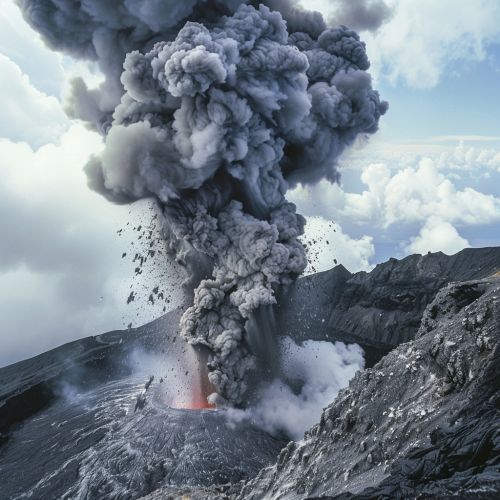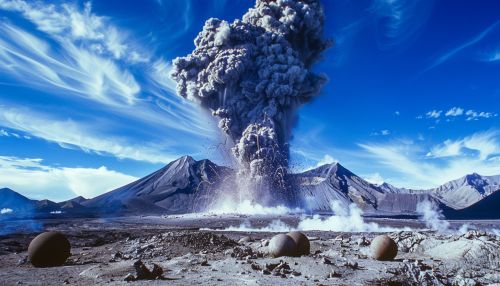Vulcanian Eruption
Introduction
A Vulcanian eruption is a type of volcanic eruption characterized by short, violent, relatively small explosions of viscous magma. These eruptions are named after the Italian island of Vulcano, where this type of activity was first described. Vulcanian eruptions are typically associated with andesitic to dacitic magmas, which are more viscous than basaltic magmas. This increased viscosity leads to the buildup of pressure within the volcanic conduit, resulting in explosive activity.
Characteristics
Vulcanian eruptions are marked by the ejection of volcanic bombs, blocks, ash, and gas. The explosions are caused by the fragmentation of viscous magma within the volcanic conduit, which is often obstructed by solidified lava or volcanic debris. This obstruction leads to a buildup of pressure until it is released explosively. The resulting eruption columns can reach heights of several kilometers, dispersing ash over wide areas.
Magma Composition
The magma involved in Vulcanian eruptions is typically andesitic to dacitic in composition. These magmas are rich in silica, which increases their viscosity. The high viscosity impedes the escape of volcanic gases, leading to the buildup of pressure. The presence of volatiles such as water vapor, carbon dioxide, and sulfur dioxide further contributes to the explosive nature of these eruptions.
Eruption Dynamics
The dynamics of Vulcanian eruptions involve a complex interplay between magma viscosity, gas content, and conduit geometry. The high viscosity of the magma leads to the formation of a solidified plug within the conduit, which traps volcanic gases. As the pressure builds, the plug is eventually fragmented, resulting in a violent explosion. The eruption typically begins with a series of small explosions, followed by one or more larger blasts.
Products of Vulcanian Eruptions
Vulcanian eruptions produce a variety of volcanic products, including volcanic bombs, blocks, ash, and pyroclastic flows. These products are ejected at high velocities and can cause significant damage to the surrounding area.
Volcanic Bombs and Blocks
Volcanic bombs are large fragments of molten rock that are ejected during an eruption. They can range in size from a few centimeters to several meters in diameter. Volcanic blocks, on the other hand, are solid fragments of rock that are ejected during the eruption. Both bombs and blocks can cause significant damage due to their size and velocity.
Ash and Tephra
Ash and tephra are fine-grained volcanic materials that are ejected during a Vulcanian eruption. Ash consists of particles less than 2 millimeters in diameter, while tephra includes larger fragments. These materials can be carried by the wind over long distances, affecting areas far from the eruption site. Ash can cause respiratory problems, damage to machinery, and disruption of air travel.


Pyroclastic Flows
Pyroclastic flows are fast-moving currents of hot gas and volcanic material that flow down the sides of a volcano during an eruption. These flows can reach speeds of up to 700 kilometers per hour and temperatures of up to 1,000 degrees Celsius. Pyroclastic flows are extremely dangerous and can cause widespread destruction.
Examples of Vulcanian Eruptions
Several well-known volcanoes have exhibited Vulcanian activity. Some notable examples include:
Sakurajima, Japan
Sakurajima is one of the most active volcanoes in Japan and has experienced numerous Vulcanian eruptions. The eruptions are characterized by explosive activity, with ash plumes reaching several kilometers into the atmosphere. Sakurajima's eruptions have caused significant disruption to the surrounding area, including the city of Kagoshima.
Anak Krakatau, Indonesia
Anak Krakatau, the "Child of Krakatoa," has exhibited Vulcanian eruptions since its formation in the early 20th century. These eruptions are marked by explosive activity, with the ejection of volcanic bombs, ash, and pyroclastic flows. The eruptions of Anak Krakatau have been closely monitored due to their potential impact on nearby populated areas.
Soufrière Hills, Montserrat
The Soufrière Hills volcano on the island of Montserrat has experienced several Vulcanian eruptions since its reawakening in 1995. These eruptions have resulted in the destruction of the island's capital, Plymouth, and the displacement of a significant portion of the population. The eruptions are characterized by explosive activity, with the ejection of ash, pyroclastic flows, and volcanic bombs.
Monitoring and Prediction
Monitoring and predicting Vulcanian eruptions is challenging due to the complex nature of the volcanic processes involved. However, advances in technology and understanding of volcanic activity have improved the ability to forecast eruptions and mitigate their impacts.
Seismic Monitoring
Seismic monitoring involves the use of seismometers to detect and record earthquakes associated with volcanic activity. The movement of magma within the conduit generates seismic signals that can be analyzed to infer the likelihood of an eruption. Increased seismic activity often precedes Vulcanian eruptions, providing a valuable tool for eruption forecasting.
Gas Emissions
The monitoring of volcanic gas emissions is another important tool for predicting Vulcanian eruptions. Instruments such as spectrometers and gas analyzers are used to measure the concentration of gases such as sulfur dioxide, carbon dioxide, and water vapor. Changes in gas emissions can indicate the movement of magma and the buildup of pressure within the conduit.
Ground Deformation
Ground deformation monitoring involves the use of GPS and InSAR (Interferometric Synthetic Aperture Radar) to detect changes in the shape of the volcano. The movement of magma within the conduit can cause the ground to deform, providing an indication of an impending eruption. Ground deformation data can be used in conjunction with seismic and gas monitoring to improve eruption forecasts.
Hazards and Mitigation
Vulcanian eruptions pose several hazards to human life and infrastructure. Understanding these hazards and implementing mitigation measures is crucial for reducing the impact of eruptions.
Ashfall
Ashfall from Vulcanian eruptions can cause respiratory problems, damage to buildings, and disruption of transportation. Mitigation measures include the use of masks to protect against inhalation of ash, the reinforcement of buildings to withstand ash loading, and the development of contingency plans for transportation disruptions.
Pyroclastic Flows
Pyroclastic flows are one of the most dangerous hazards associated with Vulcanian eruptions. These flows can cause widespread destruction and loss of life. Mitigation measures include the establishment of exclusion zones around the volcano, the construction of barriers to divert flows, and the development of early warning systems to facilitate evacuation.
Volcanic Bombs and Blocks
The ejection of volcanic bombs and blocks can cause significant damage to infrastructure and pose a direct threat to human life. Mitigation measures include the reinforcement of buildings to withstand impacts and the establishment of safety zones around the volcano.
Conclusion
Vulcanian eruptions are a complex and hazardous type of volcanic activity characterized by short, violent explosions of viscous magma. Understanding the dynamics of these eruptions, monitoring volcanic activity, and implementing mitigation measures are crucial for reducing their impact on human life and infrastructure. Advances in technology and scientific understanding continue to improve our ability to forecast and respond to Vulcanian eruptions, enhancing the safety and resilience of communities living in volcanic regions.
